Boiler feed pumps
The feed pump balances out the steam quantity supplied by the steam boiler and also water lost during surface blowdown and bottom blowdown with an appropriate quantity of feed water. To do this, the water level in the steam boiler is kept constant allowing for fluctuations within a range of roughly 100mm. Due to the regulations governing the operation of steam boilers, special requirements apply from the outset in relation to the design of boiler feed pumps as insufficient water in the boiler is a critical operating condition which must be avoided without fail.
EN 12953-6 does not impose any special requirements on pump rate and delivery pressure, providing two reliable water indicators of a special type are installed, which switch off the heating if the low water (LW) level in the boiler is undercut. Additionally, a minimum distance between the highest flues and the low water mark of at least 50mm must be maintained to ensure that the heating surfaces do not emerge as a result of re-evaporation due to the thermal energy stored in the flues.
As all Bosch shell boilers satisfy these conditions, no special requirements apply for feed pumps.
In addition to the obligations arising from the regulations, feed pumps must also satisfy the requirements for economic operation. This includes in particular keeping the water level in the boiler as constant as possible and maintaining a uniform flow rate of feed water through the existing economiser so the flue gas heat can also be continuously released to the feed water.
Likewise, the electrical output for driving the pumps should be kept as low as possible and the throttle losses via control valves minimised.
Various pump module designs are available in order to satisfy these requirements. The pumps used are vertical, high-pressure multi-stage centrifugal pumps with fully encapsulated air-cooled motor. Pumps with a drive output of up to 22kW can be equipped with an integrated inverter module for speed control. They are specially designed for use in shell boilers.
Pump characteristic map and system characteristic curves
A boiler equipped with economiser with mS = 4,000kg/h nominal steam output and pm = 13.3 bar average operating pressure is used as an example and explanation of the characteristic map of a speed-controlled boiler feed pump.
In the following figure "Example of a characteristic map of a speed-controlled boiler feed pump" the permissible range of the pump characteristic map (dark grey background) is defined on the left by the minimum flow rate curve Vmin. This is obtained from the minimum quantity required to cool the pump.
The pump characteristic map is defined on the right by the maximum flow rate Vmax, at the top by the 100% speed curve and at the bottom by the minimum heads of the individual speed curves.
The four system curves are drawn in (coloured dotted lines) to indicate the static pressure the pump needs to overcome at different operating pressures in the boiler and the dynamic pressure component due to the flow pressure losses via the pipework, valves and the economiser. As normally only short pipework sections, a few valves and the small flow resistance of the economiser need to be overcome in the boiler house, the dynamic pressure component of the system characteristic is very low. At the maximum flow rate for this boiler of 4.4m³/h this is only Δpv = 0.53 bar. The static pressure component on the other hand, which is defined by the prevailing pressure in the steam boiler, is pm = 13.3 bar. The static component therefore far outweighs the dynamic component. It still fluctuates between the minimum burner switch-on pressure pB,on = 12 bar and the maximum pressure specified by the pressure limiter pPL = 15 bar.
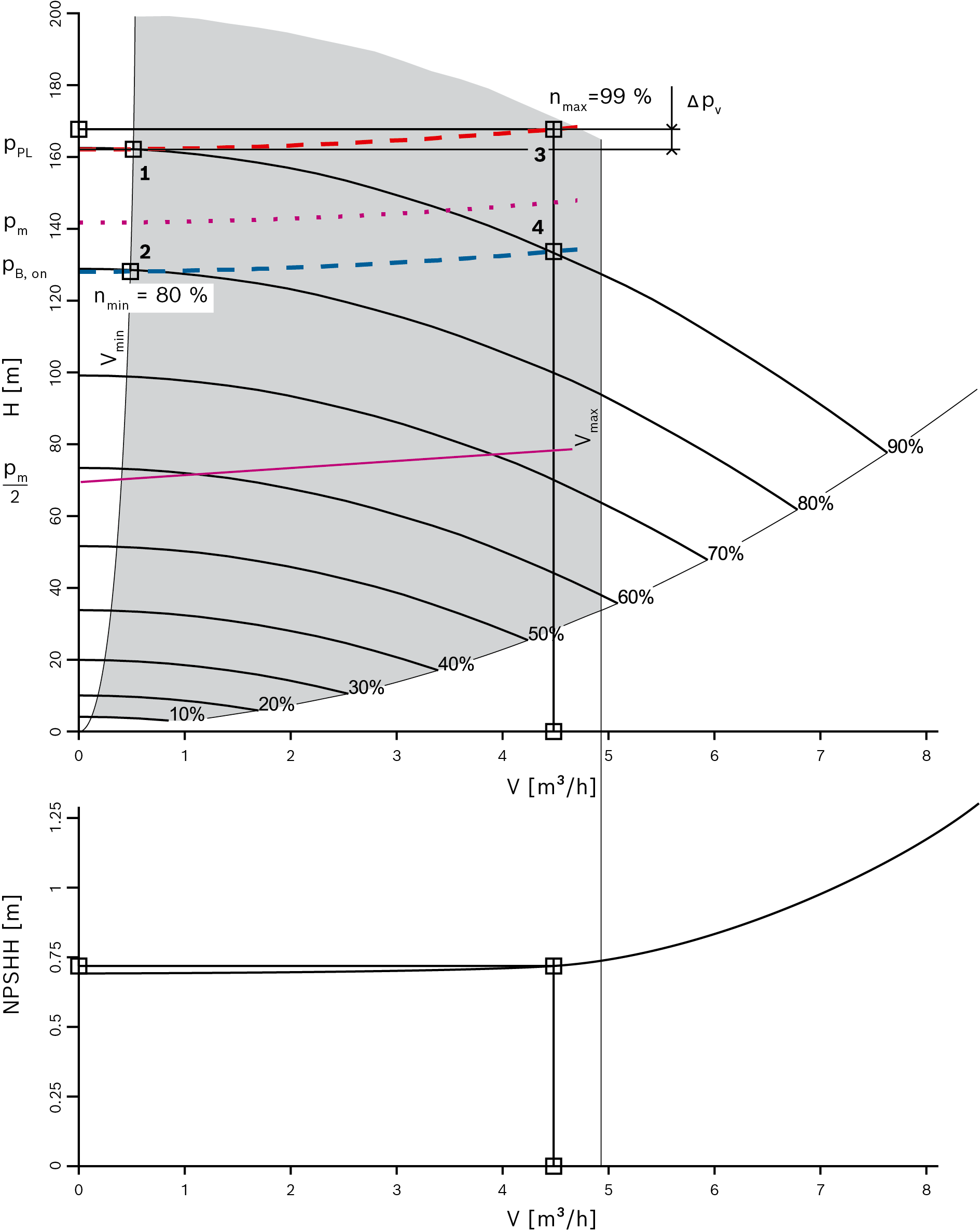
Example of a characteristic map of a speed-controlled boiler feed pump
Energy saving
As the same flow rate is required for the speed-controlled pump and an On/Off pump with control valve, energy savings are only achieved due to the lower delivery pressure and not the lower flow rate, as is the case in hot water systems.
The energy savings therefore vary, depending on the capacity utilisation and actual operating pressure of the system:
- By a few percentage points with higher capacity utilisation and operation at configured pressure
- By up to 60% during frequent operation with reduced operating pressure and lower capacity utilisation
Speed control
Due to the dominance of the static back-pressure, the speed control must limit the maximum and minimum pump speed according to the boiler pressure and therefore keep the current operating point within the range of the pump characteristic map (area highlighted in grey).
A comparison between points 1 and 4 shows just how difficult this is. While the pump only just delivers the minimum flow rate (point 1) at 90% of the pump speed with pPL = 15 bar, it already delivers the full nominal feed water flow rate (point 4) at the same speed with p(B,on) = 12 bar.
The system characteristic for the reduced operating pressure pm/2 demonstrates this even more emphatically.
NPSH (net positive suction head) value
The NPSH value states the minimum static pressure at the pump intake port at which cavitation does not yet occur. This value is predefined by the design of the pump which depends on the flow rate and increases very sharply with higher flow rates. The range to the right of the maximum flow rate of 4.9m³/h therefore cannot be used without risking damage to the pump due to cavitation.
Pump module PM
With the pump module, the boiler feed pump is mounted on a bracket and delivered ex works fully assembled with pressure display, shut-off valves, filter valves and non-return valves. To safeguard the operational availability of the boiler system if the feed pump develops a fault, two pump modules with fault response switchover are frequently installed.
Pump module with speed control
The feed pumps are also equipped with an inverter module. Because the frequency control is matched to the boiler operation, the motor speed of the pump can be steplessly controlled. This changes the pump curve which means the flow rate of the pump can be adapted to the current operating conditions in the boiler with regard to operating pressure and water level. This saves electrical drive energy, especially when the pressure in the boiler is reduced and in partial load.
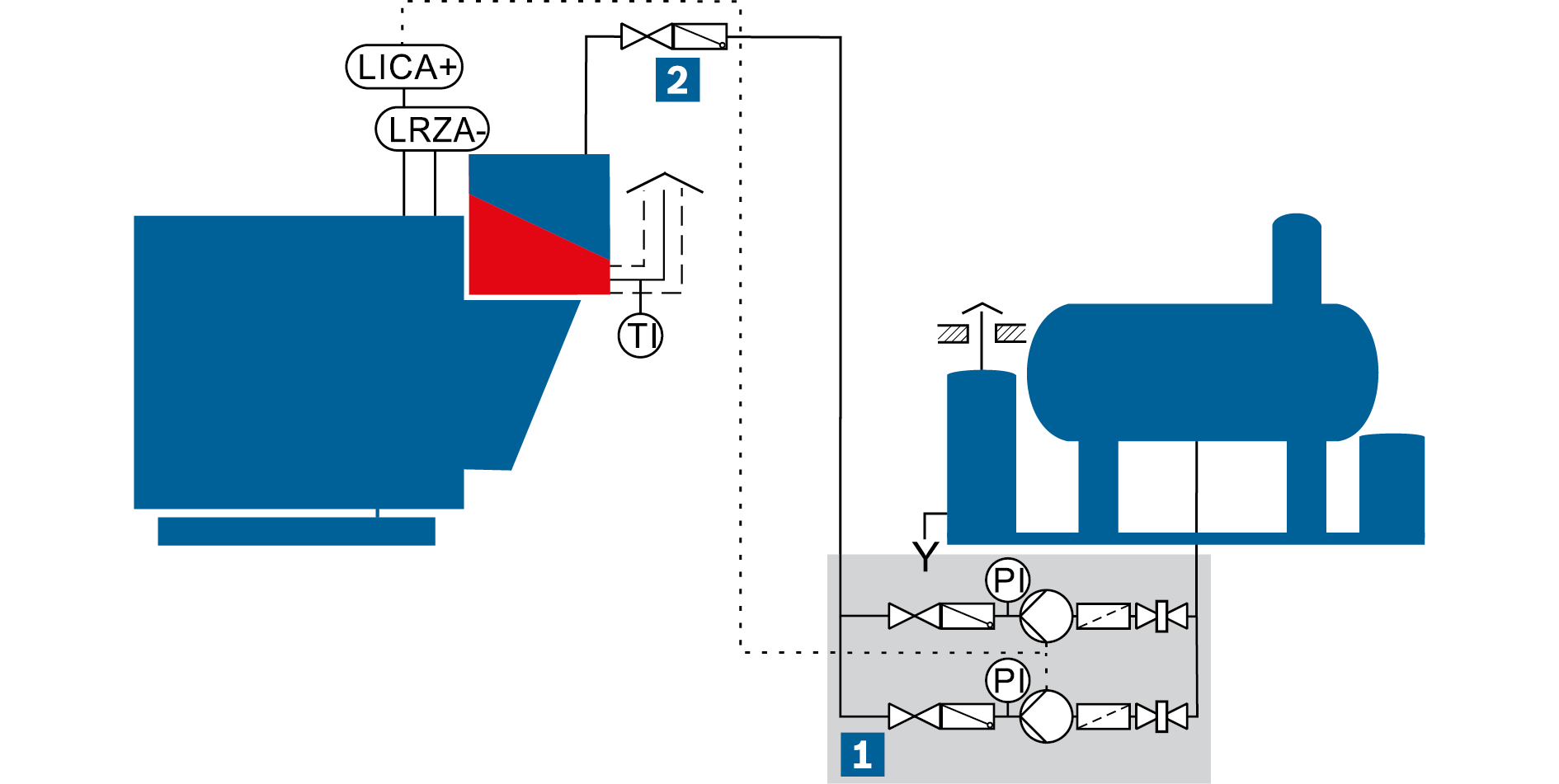
Schematic diagram of a pump module with all valves
|
|
Feed water control module |
PI |
Pressure indicator (pressure gauge) |
|
|
|
Shut-off assembly upstream of boiler |
TI |
Temperature indicator |
|
|
LICA+ |
Level transmitter |
|||
|
LRZA- |
Low water level limiter |
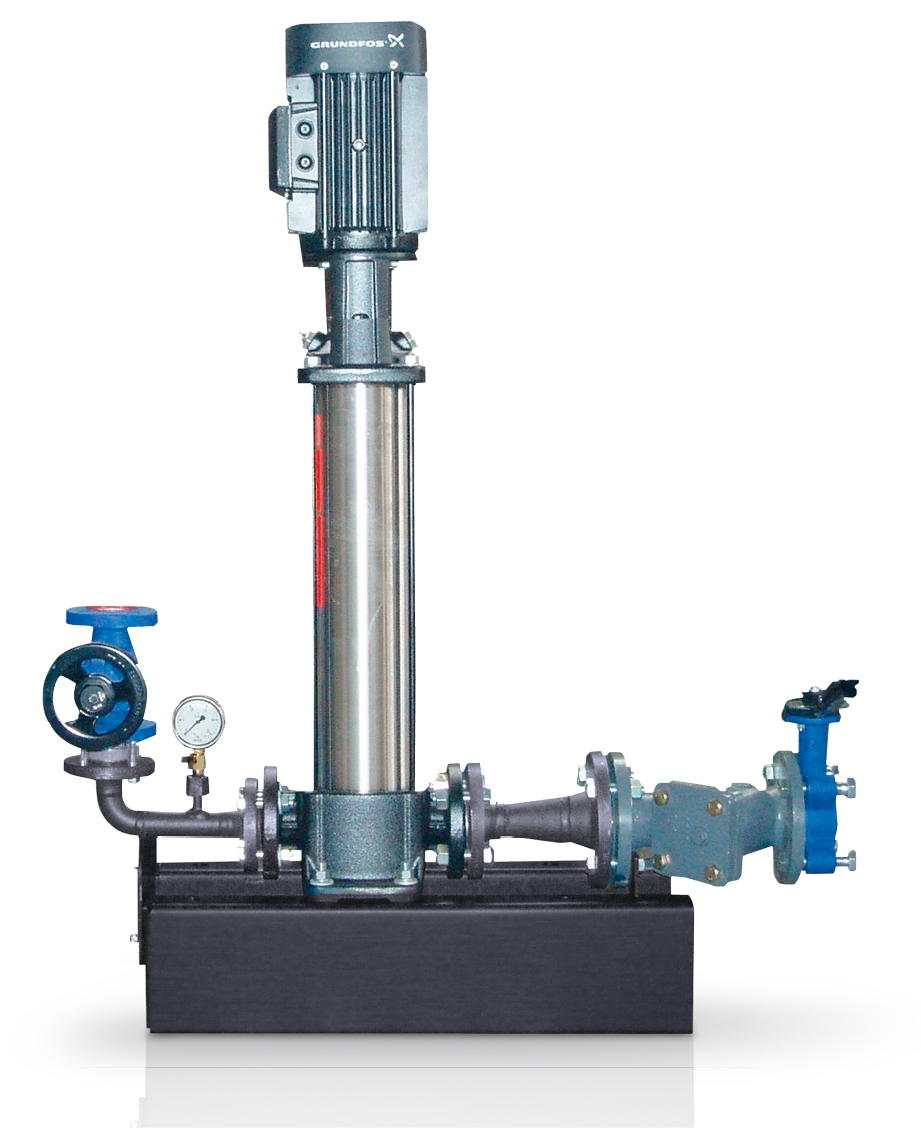
|
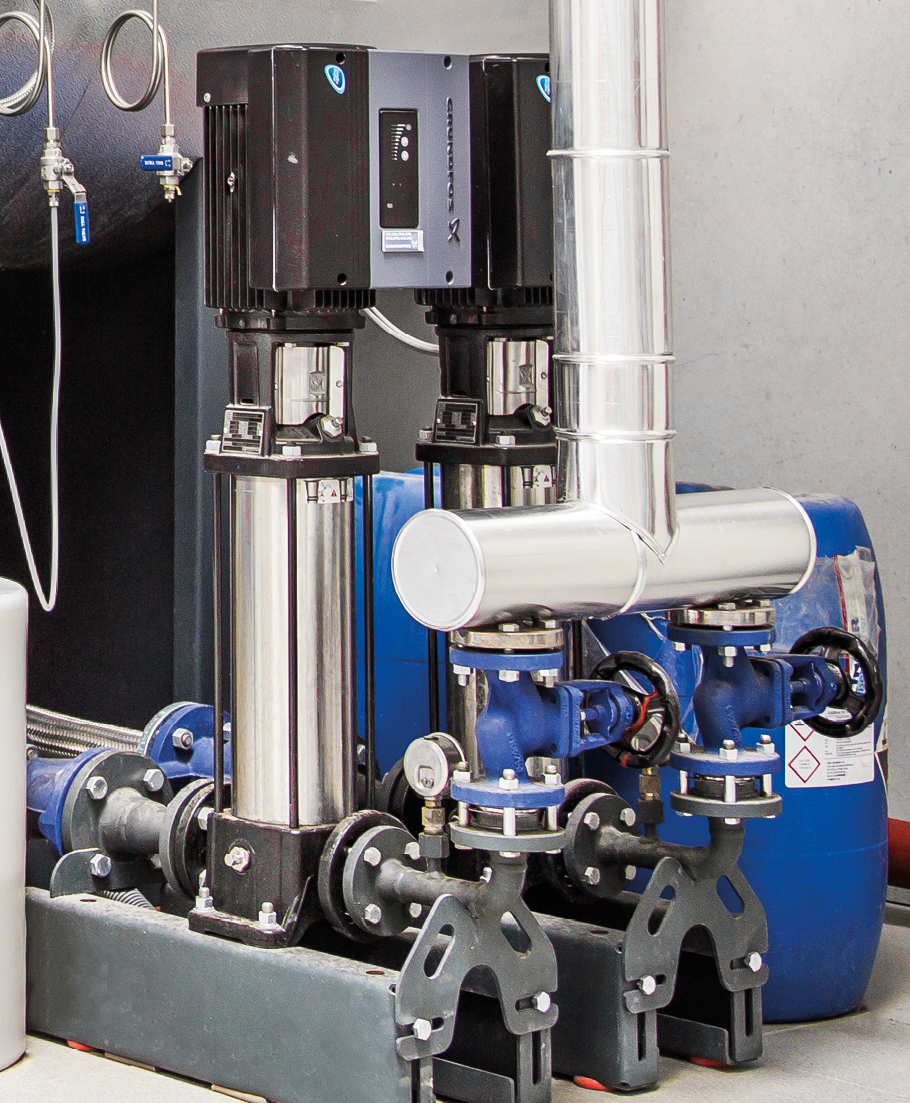
|
Benefits:
- Especially low investment costs
- Especially low operating costs
- Pump curve can be matched to different operating pressures
- Smooth start and therefore no pressure surges when switching the pump on and off
- Reduced risk of cavitation during operation because of lower flow rates
To consider:
- The control ratio of Vmin to Vmax should be at least 1:4
- When using economisers, the smallest frequency control range of the feed pump should whenever possible cover the part load control range of the burner. If necessary, a speed-controlled feed pump can also be combined with a feed water control valve.
Example and explanations of a characteristic map of a speed-controlled boiler feed pump
A speed-controlled boiler feed pump of a boiler equipped with economiser with mS = 4,000kg/h nominal steam output and pm = 13.3 bar average operating pressure is used as an example.
Pump module with/without speed control and supply control
If a speed-controlled feed pump is not installed, or if the speed-controlled pump cannot cover the necessary control range, a modulating control with the feed water control module RM is recommended for all boilers equipped with modulating burners and flue gas heat exchangers. The module ensures longer flow times in the flue gas heat exchanger and therefore optimum heat recovery from the boiler flue gases. At the same time, this also secures the minimum quantity required for the feed pump cooling via the feed water control module. The preassembled module is used in a suitable location in the feed water pressure line.
The feed water control module for stepless boiler feed consists of a feed water control valve, a drainage unit, a dirt trap and a bypass with corresponding shut-off valves.
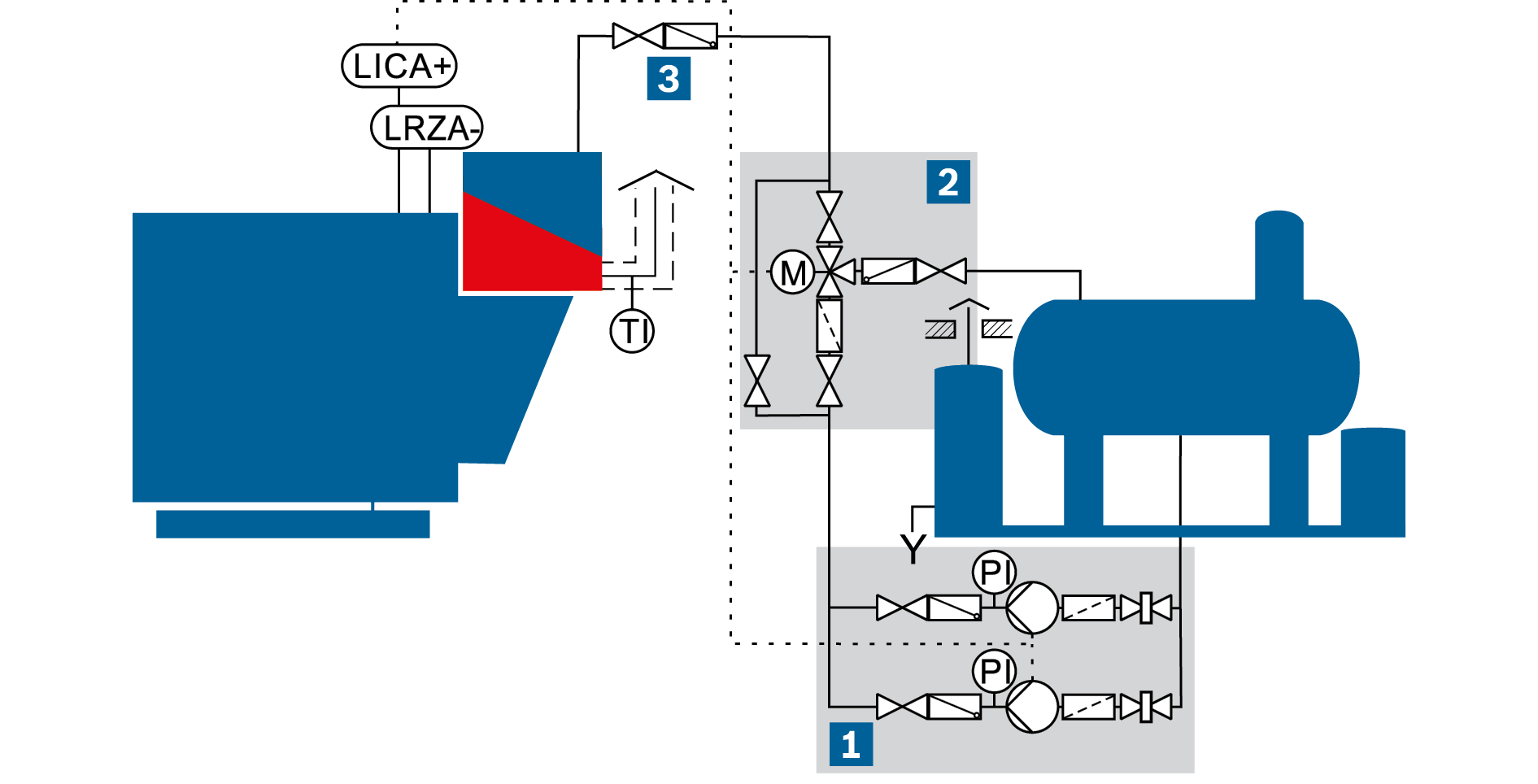
Schematic diagram of a pump module and a feed water control module with all valves
|
|
Pump module |
PI |
Pressure indicator (pressure gauge) |
|
|
|
Shut-off assembly upstream of boiler |
TI |
Temperature indicator |
|
|
|
Feed water control module |
LICA+ |
Level transmitter |
|
|
LRZA- |
Low water level limiter |
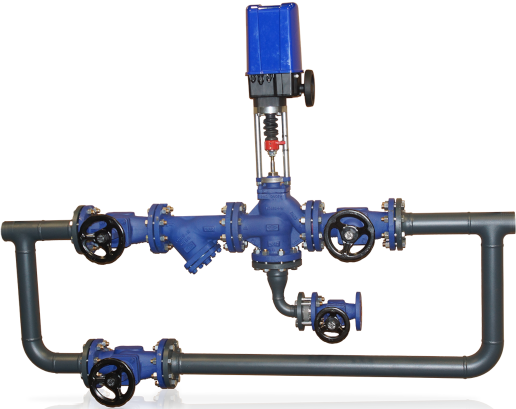
Feed water control module |
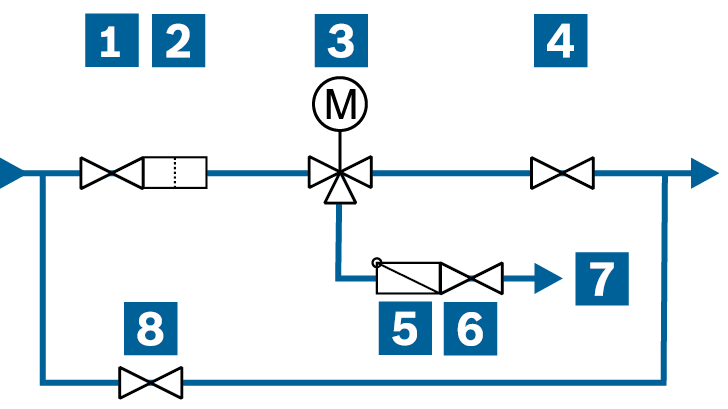
|
|
|
Shut-off valve |
|
Non-return valve |
|
|
|
Dirt trap |
|
Shut-off valve |
|
|
|
Feed water control valve with pump bypass |
|
Pump bypass to feed water vessel |
|
|
|
Shut-off valve |
|
Bypass shut-off valve |
Benefits:
- Secure minimum flow rate for cooling of feed pump
- Increased efficiency of flue gas heat exchanger
- Reduced number of pump switching operations
- Constant boiler water level










